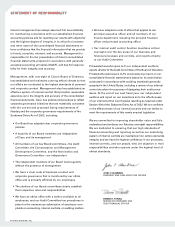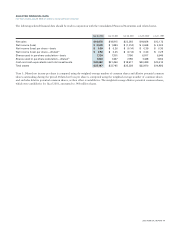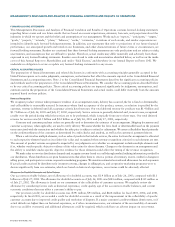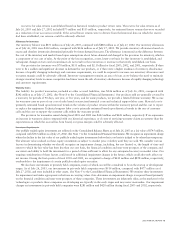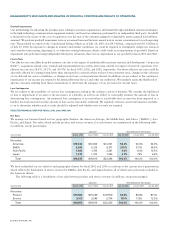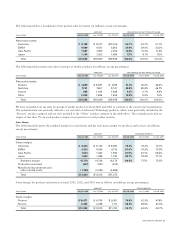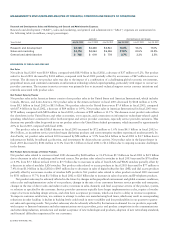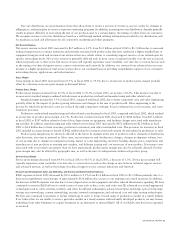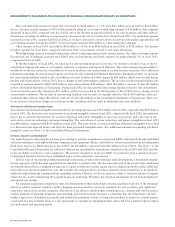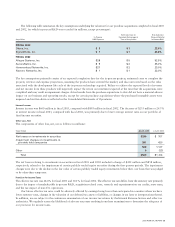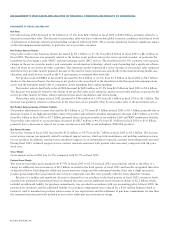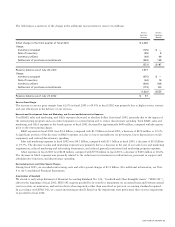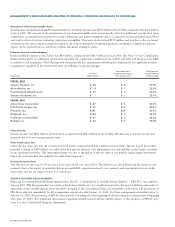Cisco 2003 Annual Report Download - page 20
Download and view the complete annual report
Please find page 20 of the 2003 Cisco annual report below. You can navigate through the pages in the report by either clicking on the pages listed below, or by using the keyword search tool below to find specific information within the annual report.
FORWARD-LOOKING STATEMENTS
This Management’s Discussion and Analysis of Financial Condition and Results of Operations contains forward-looking statements
regarding future events and our future results that are based on current expectations, estimates, forecasts, and projections about the
industries in which we operate and the beliefs and assumptions of our management. Words such as “expects,” “anticipates,” “targets,”
“goals,” “projects,” “intends,” “plans,” “believes,” “seeks,” “estimates,” variations of such words, and similar expressions are
intended to identify such forward-looking statements. In addition, any statements that refer to projections of our future financial
performance, our anticipated growth and trends in our businesses, and other characterizations of future events or circumstances, are
forward-looking statements. Readers are cautioned that these forward-looking statements are only predictions and are subject to risks,
uncertainties, and assumptions that are difficult to predict. Therefore, actual results may differ materially and adversely from those
expressed in any forward-looking statements. Readers are referred to risks and uncertainties identified below, as well as on the inside
cover of this Annual Report to Shareholders and under “Risk Factors,” and elsewhere in our Annual Report on Form 10-K. We
undertake no obligation to revise or update any forward-looking statements for any reason.
CRITICAL ACCOUNTING POLICIES
The preparation of financial statements and related disclosures in conformity with accounting principles generally accepted in the
United States requires us to make judgments, assumptions, and estimates that affect the amounts reported in the Consolidated Financial
Statements and accompanying notes. Note 2 to the Consolidated Financial Statements describes the significant accounting policies
and methods used in the preparation of the Consolidated Financial Statements. We consider the accounting policies described below
to be our critical accounting policies. These critical accounting policies are impacted significantly by judgments, assumptions, and
estimates used in the preparation of the Consolidated Financial Statements and actual results could differ materially from the amounts
reported based on these policies.
Revenue Recognition
We recognize product revenue when persuasive evidence of an arrangement exists, delivery has occurred, the fee is fixed or determinable,
and collectibility is reasonably assured. In instances where final acceptance of the product, system, or solution is specified by the
customer, revenue is deferred until all acceptance criteria have been met. Our total deferred revenue for products was $1.4 billion and
$1.7 billion as of July 26, 2003 and July 27, 2002, respectively. Service revenue is generally deferred and, in most cases, recognized
ratably over the period during which the services are to be performed, which is typically from one to three years. Our total deferred
revenue for services was $2.5 billion and $2.2 billion as of July 26, 2003 and July 27, 2002, respectively.
Contracts and customer purchase orders are generally used to determine the existence of an arrangement. Shipping documents and
customer acceptance, when applicable, are used to verify delivery. We assess whether the fee is fixed or determinable based on the payment
terms associated with the transaction and whether the sales price is subject to refund or adjustment. We assess collectibility based primarily
on the creditworthiness of the customer as determined by credit checks and analysis, as well as the customer’s payment history.
When a sale involves multiple elements, such as sales of products that include services, the entire fee from the arrangement is allocated
to each respective element based on its relative fair value and recognized when revenue recognition criteria for each element are met.
The amount of product revenue recognized is impacted by our judgments as to whether an arrangement includes multiple elements and
if so, whether vendor-specific objective evidence of fair value exists for those elements. Changes to the elements in an arrangement and
the ability to establish vendor-specific objective evidence for those elements could affect the timing of the revenue recognition.
We make sales to two-tier distribution channels and recognize revenue based on a sell-through method utilizing information provided by
our distributors. These distributors are given business terms that allow them to return a portion of inventory, receive credits for changes in
selling prices, and participate in various cooperative marketing programs. We maintain estimated accruals and allowances for such exposures.
If actual credits received by distributors for inventory returns, changes in selling prices, and cooperative marketing programs were to
deviate significantly from our estimates, which are based on historical experience, our revenue could be adversely affected.
Allowance for Doubtful Accounts and Sales Returns
Our accounts receivable balance, net of allowance for doubtful accounts, was $1.4 billion as of July 26, 2003, compared with $1.1
billion as of July 27, 2002. The allowance for doubtful accounts as of July 26, 2003 was $183 million, compared with $335 million as
of July 27, 2002. The allowance is based on our assessment of the collectibility of customer accounts. We regularly review the
allowance by considering factors such as historical experience, credit quality, age of the accounts receivable balances, and current
economic conditions that may affect a customer’s ability to pay.
Our provision (credit) for doubtful accounts was ($59) million, $91 million, and $268 million for fiscal 2003, 2002, and 2001,
respectively. In fiscal 2003, we recorded a credit for doubtful accounts as a result of the improvement in the collectibility of specific
customer accounts due to improved credit quality and resolution of disputes. If a major customer’s creditworthiness deteriorates, or if
actual defaults are higher than our historical experience, or if other circumstances arise, our estimates of the recoverability of amounts
due to us could be overstated, and additional allowances could be required, which could have an adverse impact on our revenue.
18 CISCO SYSTEMS, INC.
MANAGEMENT’S DISCUSSION AND ANALYSIS OF FINANCIAL CONDITION AND RESULTS OF OPERATIONS










